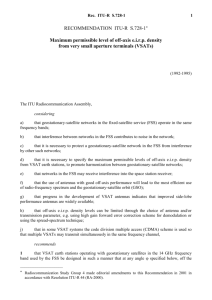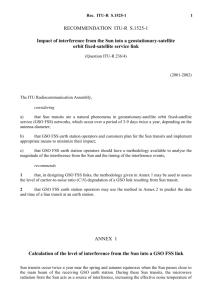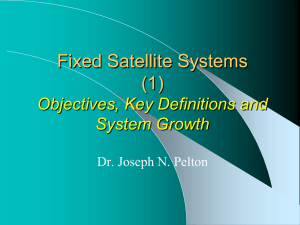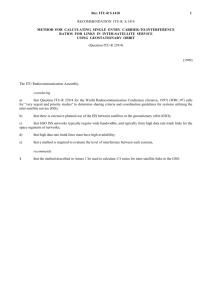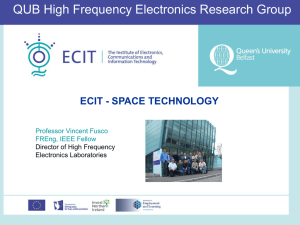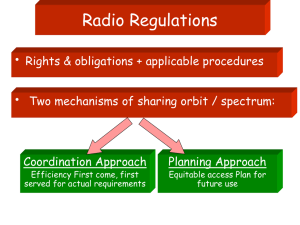S.524-6 - Maximum permissible levels of off-axis e.i.r.p. density
advertisement
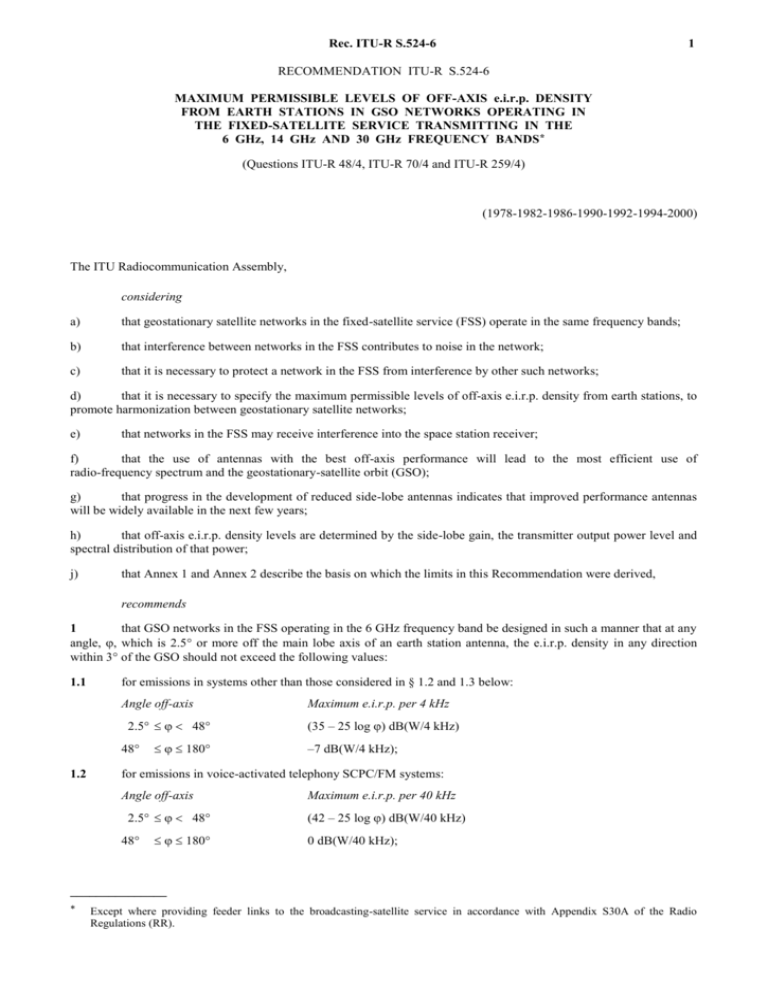
Rec. ITU-R S.524-6 1 RECOMMENDATION ITU-R S.524-6 MAXIMUM PERMISSIBLE LEVELS OF OFF-AXIS e.i.r.p. DENSITY FROM EARTH STATIONS IN GSO NETWORKS OPERATING IN THE FIXED-SATELLITE SERVICE TRANSMITTING IN THE 6 GHz, 14 GHz AND 30 GHz FREQUENCY BANDS* (Questions ITU-R 48/4, ITU-R 70/4 and ITU-R 259/4) (1978-1982-1986-1990-1992-1994-2000) Rec. ITU-R S.524-6 The ITU Radiocommunication Assembly, considering a) that geostationary satellite networks in the fixed-satellite service (FSS) operate in the same frequency bands; b) that interference between networks in the FSS contributes to noise in the network; c) that it is necessary to protect a network in the FSS from interference by other such networks; d) that it is necessary to specify the maximum permissible levels of off-axis e.i.r.p. density from earth stations, to promote harmonization between geostationary satellite networks; e) that networks in the FSS may receive interference into the space station receiver; f) that the use of antennas with the best off-axis performance will lead to the most efficient use of radio-frequency spectrum and the geostationary-satellite orbit (GSO); g) that progress in the development of reduced side-lobe antennas indicates that improved performance antennas will be widely available in the next few years; h) that off-axis e.i.r.p. density levels are determined by the side-lobe gain, the transmitter output power level and spectral distribution of that power; j) that Annex 1 and Annex 2 describe the basis on which the limits in this Recommendation were derived, recommends 1 that GSO networks in the FSS operating in the 6 GHz frequency band be designed in such a manner that at any angle, , which is 2.5 or more off the main lobe axis of an earth station antenna, the e.i.r.p. density in any direction within 3 of the GSO should not exceed the following values: 1.1 for emissions in systems other than those considered in § 1.2 and 1.3 below: Angle off-axis 2.5 48 48 1.2 180 Maximum e.i.r.p. per 4 kHz (35 – 25 log ) dB(W/4 kHz) –7 dB(W/4 kHz); for emissions in voice-activated telephony SCPC/FM systems: Angle off-axis 2.5 48 48 180 Maximum e.i.r.p. per 40 kHz 42 – 25 log ) dB(W/40 kHz) 0 dB(W/40 kHz); _______________ * Except where providing feeder links to the broadcasting-satellite service in accordance with Appendix S30A of the Radio Regulations (RR). 2 1.3 Rec. ITU-R S.524-6 for emissions in voice-activated telephony SCPC/PSK systems: Angle off-axis Maximum e.i.r.p. per 40 kHz 2.5 48 48 180 (45 – 25 log ) dB(W/40 kHz) 3 dB(W/40 kHz); 2 for new antennas of an earth station operating in the 6 GHz band, using emissions other than those considered in § 1.2 and 1.3, after 1988 the e.i.r.p. density should not exceed the following values: Angle off-axis 2.5 7 Maximum e.i.r.p. per 4 kHz 7 (32 – 25 log ) dB(W/4 kHz) 9.2 11 dB(W/4 kHz) 9.2 48 48 180 (35 – 25 log ) dB(W/4 kHz) –7 dB(W/4 kHz); 3 that earth stations operating in GSO networks in the FSS operating in the 12.75-13.25 GHz and 13.75-14.5 GHz frequency bands be designed in such a manner that at any angle, , which is 2.5 or more off the main lobe axis of an earth station antenna, the e.i.r.p. density in any direction within 3 of the GSO should not exceed the following values: Angle off-axis 2.5 7 Maximum e.i.r.p. per 40 kHz 7 (39 – 25 log ) dB(W/40 kHz) 9.2 18 dB(W/40 kHz) 9.2 48 48 180 (42 – 25 log ) dB(W/40 kHz) 0 dB(W/40 kHz); 4 that earth stations operating in GSO networks in the FSS operating in the 29.5-30 GHz frequency band be designed in such a manner that at any angle, , which is 2 or more off the main lobe axis of an earth station antenna, the e.i.r.p. density in any direction within 3 of the GSO should not exceed the following values: Angle off-axis Maximum e.i.r.p. per 40 kHz 2 7 (19 – 25 log ) dB(W/40 kHz) 7 9.2 –2 dB(W/40 kHz) 9.2 48 48 180 (22 – 25 log ) dB(W/40 kHz) –10 dB(W/40 kHz). For any direction in the region outside 3 of the GSO, the above limits may be exceeded by no more than 3 dB; 5 that the following Notes should be regarded as part of this Recommendation. NOTE 1 – Values in § 1.2 above are based on a mean power noise analysis. Possible subjective effects of interference into an SCPC-FM carrier by a very narrow bandwidth emission have not been considered. Further studies are required on this matter. NOTE 2 – Limits in § 1.2 above apply to normal operation of voice telephony in a 4 kHz baseband. NOTE 3 – The values contained in § 1.1 above have been derived mainly from an analysis of FM systems used for analogue television or multi-channel telephony. It is not known at the present time whether telecommand and ranging systems operating in the emission band and some types of SCPC system different from those mentioned in § 1.2 and 1.3, comply with these provisions. Studies should be undertaken in order to determine how these systems could comply with the limits above. NOTE 4 – Enhanced orbit utilization and easier coordination would be attained with lower side-lobe e.i.r.p. values, and therefore, administrations are encouraged to achieve lower values where practicable. Rec. ITU-R S.524-6 3 NOTE 5 – Wherever practicable, existing earth stations should comply with the values above. NOTE 6 – The provisional values contained in § 2 have been derived from advanced, low side-lobe antenna patterns, taking into account the principles of Note 3. Further studies of earth station antenna performance at angles close to the main beam, and particularly in respect of the validity of 7° as a value up to which it is reasonable to recommend this 3 dB tightening of the off-axis e.i.r.p. density limit, are urgently needed. These studies should also include consideration of the impact of the values in § 2 on antennas with operating bandwidths greater than 500 MHz. NOTE 7 – It may be necessary, in frequency planning, to avoid situations where television transmissions in one network use the same frequencies as single channel per carrier (SCPC) telephony transmissions in a network using a nearby satellite. NOTE 8 – When uplink power control is used and rain fades make it necessary, the limiting values stated in § 3 may be exceeded for the duration of that period. In rain climates N and P in the case when uplink power control is not used, the limits given in § 3 may be exceeded by y dB. The value of y dB needs to be determined by further studies based on reliable propagation data to establish fade margins with adequate accuracy. Table 2 provides further guidance on this subject. NOTE 9 – Administrations operating earth stations in the 14 GHz band are encouraged to reduce the off-axis e.i.r.p. density by increasing the required antenna diameter, employing improved antenna side-lobe performance or, in the case of FM-TV, to use an appropriate form of energy dispersal, if applicable. NOTE 10 – For FM-TV transmissions, administrations are encouraged to reduce interference to other networks by using either programme material or appropriate test patterns, together with energy dispersal, at all times. Figure 1 of Annex 1 provides an example of typical spectral distribution of a FM-TV carrier modulated by programme material, together with energy dispersal. NOTE 11 – The use of reduced satellite spacing will require further study of the e.i.r.p. limit for off-axis angles below 2.5. NOTE 12 – FM-TV emissions with energy dispersal in the 12.75-13.25 and 13.75-14.5 GHz bands may exceed the limits in § 3 above by up to 3 dB provided the off-axis total e.i.r.p. of the emitted FM-TV carrier does not exceed the following values: Angle off-axis 2.5 7 Maximum e.i.r.p. 7 (53 – 25 log ) dBW 9.2 32 dBW 9.2 48 48 180 (56 – 25 log ) dBW 14 dBW NOTE 13 – For FM-TV carriers in the 12.75-13.25 and 13.75-14.5 GHz band which operate without energy dispersal, such carriers should be modulated at all times with programme material or appropriate test patterns. In this case, the offaxis total e.i.r.p. of the emitted FM-TV carrier should not exceed the following values: Angle off-axis 2.5 7 Maximum e.i.r.p. 7 (53 – 25 log ) dBW 9.2 32 dBW 9.2 48 48 180 (56 – 25 log ) dBW 14 dBW NOTE 14 – For GSO systems in which the earth stations are expected to transmit simultaneously in the same 40 kHz band, e.g. for the GSO systems employing code division multiple access (CDMA), the maximum e.i.r.p. values in recommends 4 should be decreased by 10 log(N ) dB, where N is the number of earth stations which are in the receive satellite beam of the satellite to which these earth stations are communicating and which are expected to transmit simultaneously on the same frequency. NOTE 15 – Earth stations operating in the 29.5-30 GHz frequency band should be designed in such a manner that 90% of their peak off-axis e.i.r.p. density levels do not exceed the values given in recommends 4. Further study is needed to determine the off-axis angular range over which these exceedances would be permitted, taking into account the interference level into adjacent satellites. The statistical processing of the off-axis e.i.r.p density peaks should be dealt with using the method given in Recommendation ITU-R S.732. 4 Rec. ITU-R S.524-6 NOTE 16 – The off-axis e.i.r.p density values given in recommends 4 do not apply to earth stations put into operation at any time and operating with GSO networks brought into use before the end of WRC-2000. NOTE 17 – The values in recommends 4 are maximal values under clear-sky conditions. In case of systems employing uplink power control, these levels include any additional margins above the minimum clear-sky level necessary for the implementation of uplink power control. During rain faded conditions, the levels in recommends 4 may be exceeded by earth stations when implementing uplink power control. The amount by which the levels in recommends 4 may be exceeded should be such that the received signal level by the associated space station should not be exceeded by more than P (dB) compared to the level under the clear-sky conditions. Further study is required to determine the value of P, taking into account the possibility that a statistical definition of P, as a percentage of time, may be appropriate. The studies should also take account of the inherent requirement for accurate uplink power control to limit the level of self interference from co-frequency operation of adjacent beams. NOTE 18 – FSS earth stations operating in the 29.5-30 GHz band, which have lower elevation angles to the GSO will require higher e.i.r.p levels relative to the same terminals at higher elevation angles to achieve the same power flux-densities (pfds) at the GSO due to the combined effect of increased distance and atmospheric absorption. Earth stations with low elevation angles may exceed the levels of recommends 4 by the following amount (see Annex 2): Elevation angle to GSO, 5 5 30 Increase in e.i.r.p density (dB) 2.5 0.1(25 – ) 0.5 NOTE 19 – The levels given in recommends 3 may be exceeded by telecommand and ranging carriers transmitted to GSO-FSS satellites in both normal and emergency modes of telecommand operation. The amount by which these levels may be exceeded when operating in normal mode is 16 dB. For earth stations operating and ranging carriers in the 29.5-30 GHz band further study is required. NOTE 20 – The definition of recommended maximum off-axis e.i.r.p density levels for earth stations operating with GSO networks in the 27.5-29.5 GHz frequency band requires taking into account existing GSO networks and the sharing environment with other services in this band. NOTE 21 – The levels in recommends 4 have been developed based on the e.i.r.p levels required to achieve the performance objectives of most digital GSO FSS systems excluding some of the networks defined in Note 16. However these levels may create a higher level of interference into some digital systems employing multiple spot beams and small earth station antennas operating in close orbital spacing environment. Analogue systems have not been taken into account. NOTE 22 – The values in recommends 4 applicable to the off-axis angle range from 48 to 180 are intended to account for spillover effects. Further study is required on the range of off-axis angles over which these effects occur. ANNEX 1 1 Introduction Interference from an earth station transmitter into the satellite receivers of other networks can be related directly to the off-axis spectral e.i.r.p. density of the interfering earth station antenna. This is a function not only of the earth station antenna side-lobe performance but also depends on the transmitter power level and its spectral density which, in turn, will be influenced by the overall satellite system design. The establishment of a recommended limit for off-axis spectral e.i.r.p. density can be approached from two viewpoints: – limitation of the interference level entering another satellite taking particular account of interference to networks employing large earth station antennas; – determination of the on-axis e.i.r.p. requirements for earth stations, particularly those employing relatively small antennas and consideration of the on-axis and off-axis gain that such antennas could be expected to provide. Rec. ITU-R S.524-6 2 5 Consideration of an off-axis e.i.r.p. density limit for the 6 GHz band An examination from both of the viewpoints mentioned above has led to the conclusion that the recommended limit should take the following form for uplink emission at about 6 GHz. At any angle, , 2.5 or more off the main lobe axis of an earth station antenna, the e.i.r.p. per 4 kHz in any direction within 3 of the GSO should not exceed the following values: Angle off-axis 2.5 25 25 < 180 Maximum e.i.r.p. per 4 kHz (E – 25 log ) dB(W/4 kHz) (E – 35) dB(W/4 kHz) where the value of E should be within the range 32.0 to 38.5. The value of E should be as small as practicable, and will vary from one frequency band to another. For some satellite system applications, it may be desirable to develop an off-axis e.i.r.p. density limit by using a more stringent value of E (e.g. 32) in the near-in angular region (e.g. 7°) and then to relax the value of E at larger off-axis angles. This type of stepped limit would constrain the off-axis radiation in those angular regions where the value would be more effective in limiting interference to adjacent satellites. From the viewpoint of tolerable interference into a satellite network with large station antennas, it may be noted that a value of 38.5 for E would permit a maximum e.i.r.p. density of 21.0 dB(W/4 kHz) to be radiated from an earth station at 5 off-axis. From the viewpoint of the reasonable requirements of earth stations with small antennas, four cases that might be considered are: Case 1: high density FM carrier – large station; Case 2: FM-TV – small station (global satellite antenna); Case 3: FM-TV – broadcast satellite uplink; Case 4: SCPC – narrow-band. Assuming the following: – the satellite noise temperature 3 000 K; – the satellite antenna gain 16 dB; – the earth-station antenna conforms to Recommendation ITU-R S.465 for off-axis angles less than 25, but the sidelobe envelope has a constant level of –3 dBi beyond 25; – 10 log (earth station noise temperature) 19. (Values for the minimum power density at an off-axis angle of 5 are shown in Table 1.) The worst interference would be from Case 2 where a 53 dB gain corresponds to a 10 m diameter antenna. The required transmitter power would be about 500 W. With 27 dB (2 MHz) of spreading advantage, the nominal transmit power density would be 0 dB(W/4 kHz) resulting in an off-axis radiation of 14.5 dB(W/4 kHz) at 5. While Case 4 indicates a similar value for off-axis e.i.r.p. density radiations, other factors must be considered. SCPC are low level carriers with a nominal earth station transmit level of 63.5 dB(W/channel). Since TV normally only has spreading at a slow rate (25 or 30 Hz), it is considered that the total carrier power must be considered as pulsed interference. In this case, at 5 the C/I would be 22 dB on the uplink and 13 dB on the downlink. While criteria for interference in these cases do not exist, an overall C/I of 20 dB has been adopted in some analyses for such pulsed interference. Recognizing the severe incompatibility of this situation, the conclusion is reached that adequate protection is not reasonably attainable by satellite separation nor by more severe e.i.r.p. restrictions since the downlink is dominant. 6 Rec. ITU-R S.524-6 One solution is to restrict the uses of the two types of signals such that they would also be separated in frequency where the FSS is involved on both uplinks and downlinks. A second solution which might considerably relieve the problem noted above is a different method of carrier energy dispersal for television by transformation of the video signal. TABLE 1 Minimum off-axis e.i.r.p. density for typical carriers FDM-FM 1 332 channels 36 MHz RF bandwidth FM-TV FM-TV broadcasting satellite uplink SCPC global Satellite G/T (dB(K–1)) –7 –17 0 –17 Uplink C/T (dB(W/K)) –125 –137 –134 –154 e.i.r.p. (dBW) 82 80 66 63 Earth station antenna transmit gain (dB) 60 53 46 53 RF power input to earth station antenna (dBW) 22 27 20 10 RF spectral power density input to earth station antenna (dB(W/4 kHz)) –8 0 –4 0 E5 (dB(W/4 kHz)(1) (1) 6.5 14.5 10.5 14.5 Radiation at 5 assuming 32 – 25 log relationship Two examples from the Canadian TELESAT system show that at 6 GHz and an off-beam angle of 5, a level of unwanted e.i.r.p. density in the approximate range 17-18 dB(W/4 kHz) is associated with SCPC transmissions from a 4 to 5 m diameter antenna and with TV transmissions from a 10 m diameter antenna. As to Case 4, a study was made in Japan on the off-axis e.i.r.p. density per 4 kHz bandwidth for the SCPC-PSK carrier of the INTELSAT system and SCPC-FM and SCPC-PSK carriers of the MARISAT system. Based on the results of the above studies, it may be concluded that in the case of a transmission between Standard-B earth stations in the INTELSAT system, the worst value of off-axis e.i.r.p. density from the transmitting earth station is 6 dB higher than 35 25 log (dB(W/4 kHz)). It should be noted that these figures are only an illustrative example of existing systems. In any event a Recommendation should not be tailored to a specific existing system but on the contrary future systems should be designed to meet the Recommendation in its final form. Based on the foregoing, it is concluded that the utilization of the GSO at about 6 GHz could be protected, while permitting earth stations with antennas as small as 4 or 5 m in diameter to be used, by applying the following guidelines: – care should be exercised in frequency planning to ensure that television transmissions in one network do not use the same frequencies as SCPC telephony transmissions in a network using a nearby satellite; – in all other cases, earth stations should conform to the off-axis e.i.r.p. spectral density limits in the direction of the GSO indicated in the second paragraph of this section, the value of E lying within the range 32.0 to 38.5. Rec. ITU-R S.524-6 3 7 Consideration of off-axis e.i.r.p. density limit for the 10-15 GHz band When considering an off-axis e.i.r.p. density limit at 10-15 GHz it is reasonable to assume that the satellite receive antenna will not normally provide wide angle coverage and on this account it may be possible to utilize lower earthstation e.i.r.p.s and hence lower levels of off-axis radiation than in the lower frequency bands. However, this may be counteracted by the fact that rain fading will be more severe. 3.1 Method of calculation of E In general, the interference, I, from a transmitting earth station into an interfered-with space station from the intended transmission is given by: I E – 25 log LFS LCA LR Gs (1) where: E: constant to be determined for a limit formula related to a reference bandwidth LFS : free-space loss at the transmitting frequency LCA : clear-air attenuation LR : attenuation due to rain (in the worst case LR 0, in clear-air conditions) Gs : gain of the antenna of the interfered-with satellite in the direction of the interfering earth station. The single entry uplink interference, I, may be specified to be constrained to be equal to a fraction of the up-path thermal noise of the interfered-with space station. In that case: I 10 log (k T B) (2) where: : thermal noise-to-interference power ratio T: noise temperature at the satellite receiver input B: bandwidth under consideration k: Boltzmann’s constant. Then, in the worst case where LR 0: E 25 log 10 log k B LFS LCA (G/T )s (3) where (G/T)s : satellite figure of merit (dB(K–1)). If the free-space loss is 207 dB (14 GHz) and the clear-air attenuation is 0.5 dB this simplifies to: E 25 log 21.1 (G/T )s B (4) Thus for given parameters , (G/T )s, B and , the parameter E which defines the permissible e.i.r.p. density from an earth station at angle off-axis can be determined. However, other factors should also be taken into account in choosing an off-axis limitation to the e.i.r.p. of emissions from transmitting earth stations in the 10-15 GHz bands. One such factor is the need to consider rain margins in the earth stations’ e.i.r.p. budgets at these frequencies; another is that constraining the off-axis e.i.r.p. density values to certain limits may have a significant influence on the earth station antenna diameter. An example of how antenna diameter varies with E for three different uplink rain margins is shown in Table 2a. The impact on the parameter E of the need to take account of adverse propagation conditions, in a region of high rainfall (Brazil) is exemplified in Table 2b. 8 Rec. ITU-R S.524-6 TABLE 2a Required earth-station antenna diameters in an assumed television mode of operation to meet specified off-axis e.i.r.p. density values Antenna diameter (m) E (dB(W/40 kHz)) Rain margin 0 dB Rain margin 3 dB Rain margin 6 dB 33 12 17 24 36 8 12 17 39 6 8 12 42 4 6 8 Assumptions made in deriving Table 2a: – TV carrier with 2 MHz peak-to-peak energy dispersal modulation only; – reference bandwidth for E 40 kHz; – earth-station side-lobe gain given by 29 – 25 log (dBi); – earth-station antenna efficiency 57-65%; – 14 GHz operation; – clear-air C/T required at satellite input –127 dBW(K–1); – satellite G/T –3 dB(K–1). TABLE 2b Examples of the increase in off-axis e.i.r.p. density for systems designed to cope with large propagation fades E (dB(W/40 kHz)) Carrier FM-TV Clear-sky model Deep-fade model A 29 A 32 A 29 A 32 34 37 47 50 Where earth-station side-lobe gain is A – 25 log (dBi). Assumptions made in deriving Table 2b: – TV carrier with 2 MHz peak-to-peak energy dispersal modulation only; – 60 earth-station elevation angle; – uplink availability better than 99.9%; – 14 GHz operation. Rec. ITU-R S.524-6 3.2 9 Factors affecting E In addition to the rain margin included in the “interfering” uplink design there are a number of variables which impact on the value of E for satellite services: a) “Interfering” carrier type Recognizing that, in transponders amplifying multiple FM carriers, power spectral density, and hence the interference potential, does not vary greatly between carriers of different capacity, consideration can perhaps be limited to cases in which a transponder carries the following signals: – multiple FDM-FM carriers; – multiple “high density” FDM-FM carriers; – a single FDM-FM carrier; – one PCM-PSK-TDMA carrier; – SCPC-PCM-PSK multiple carriers; – FM-TV, single carrier, with 2 MHz carrier energy dispersal; – SCPC-FM multiple carriers. The e.i.r.p. spectral density required for the uplink of each of these carriers will further depend on whether it is destined for reception at large or small antenna receiving terminals. b) “Interfered-with” carrier type A similar range of cases as in a) above should be considered. c) Interference objective ITU-R studies have considered the possibility of increasing the interference allowance in the interest of decreasing satellite spacing. d) Satellite spacing In the frequency range 10-15 GHz, spacings of 3 for co-coverage satellites have been implemented, but increased demand for service has prompted consideration of 2 spacing in certain locations. e) “Interfered-with” satellite coverage area Satellite G/T values corresponding to typical regional and domestic coverages should be considered. f) “Interfering” earth station side-lobe gain characteristic As improved designs of earth station antenna are brought into service, off-axis emissions will reduce. g) Rain margin included in the “interfered-with” uplink design Full consideration of all these factors would involve thousands of combinations, and a correspondingly wide range of E. In deriving this list the assumption is made that the values of earth station antenna diameter and transmitter power required to simultaneously meet the “wanted” uplink e.i.r.p. and the off-axis e.i.r.p. limit will be chosen. There may be circumstances where this is impractical, e.g. small transportable earth stations being used to provide short duration television uplinks from various locations in a satellite’s coverage area. Table 3 gives an example of the inter-relationship between parameter E and factors c) to f) inclusive. Both interfering and interfered-with carriers are frequency modulated by television signals and are assumed to be identical. Combinations of earth station antenna size and transmitter power have been chosen which provide the required e.i.r.p. for the wanted carrier whilst just meeting the up-path interference objectives. It should be noted that this example assumes two identical satellite systems. Wider variations in E and in the earth station parameters would result from the inclusion of cases where the satellites in the interfering and interfered-with systems had different G/T values. 10 Rec. ITU-R S.524-6 TABLE 3 Optimum E values and related parameters for FM-TV to FM-TV interference Satellite G/T (dB(K–1)) –3 Satellite spacing (degrees) 2 Interference objective (% of up-path thermal noise) Earth-station side-lobe gain 32 – 25 log Earth-station side-lobe gain 29 – 25 log Earth-station side-lobe gain 26 – 25 log 3 2 3 20 50 20 50 20 50 20 50 Antenna diameter (m) 10.7 6.8 6.4 4.1 26.9 17.1 16.2 10.3 Transmitter power (W) 139 342 382 951 3.5 8.6 9.6 23.9 Antenna diameter (m) 7.6 4.8 4.6 2.9(1) 19.0 12.1 11.5 7.3 Transmitter power (W) 287 685 764 1 903(1) 7.0 17.2 19.2 47.8 Antenna diameter (m) 5.3 3.4 3.2(1) 2.0(1) 13.4 8.5 8.1 5.1 Transmitter power (W) 557 1 385 1 517(1) 3 794(1) 14.0 34.8 38.1 95.3 28.4 32.4 32.8 36.8 20.4 24.4 24.8 28.8 Off-axis e.i.r.p. parameter E (dB(W/40 kHz)) (1) –5 In these cases, larger antennas and lower transmitter powers would probably be chosen in practice and in these circumstances the interference would be well within the prescribed limits. Assumptions made in deriving Table 3: – “interfering” and “interfered-with” earth-stations at 15 elevation; – 14 GHz operation; – satellite antenna gain the same for “interfering” and “interfered-with” up paths; – earth-station antenna efficiency 65%; – 3 dB rain attenuation on “interfered-with” up path only; – up-path C/T of “interfered-with” TV carrier –130 dBW(K–1); – modulation by energy dispersal signal only, 2 MHz peak-to-peak deviation. 3.3 Spectral distribution of modulated FM-TV carrier To study the effects of interference into narrow-band carriers due to FM-TV carriers modulated by program material together with energy dispersal, the spectral characteristics of a 20 MHz NTSC TV carrier were measured. Figure 1 shows spectral density distribution of the TV carrier modulated by a live video signal plus energy dispersal causing 1 MHz peak-to-peak deviation, not exceeded for various percentages of time. 4 Consideration of off-axis e.i.r.p. density limits for the band 29.5-30 GHz (see Note 1) 4.1 Evidence in supporting of recommends 4 At the time of writing there are two sources of data in ITU-R documentation on GSO/FSS carriers using, or planned to use, the 29.5-30 GHz band; one is Recommendation ITU-R S.1328, and the other is the database compiled from the responses by administrations to Circular Letters CR/92 and CR/116 (see Note 2) issued in 1998 and 1999 respectively during the preparation for WRC-2000 (hereafter this is termed the CR/116 database for convenience). Rec. ITU-R S.524-6 11 FIGURE 1 Spectral distribution of a 20 MHz FM-TV carrier modulated by NTSC live video plus 1 MHz energy dispersal –58 –63 –68 98% Density (dBc/Hz) –73 90% –78 –83 –88 –93 80% –98 50% –103 –108 60 62 64 66 68 70 Frequency (MHz) 72 74 76 78 80 0524-01 FIGURE 1/S.524-6...[0524-01] = 3 CM For most of its GSO FSS carriers Recommendation ITU-R S.1328 contains sufficient information to enable the off-axis e.i.r.p. spectral density transmitted by the uplink earth station to be calculated, if realistic assumptions are made for the earth station antenna radiation pattern (e.g. Recommendation ITU-R S.580) for the few carriers where it is missing. There is also enough data to calculate, for each carrier, the degradation in the clear-air (C/N ) which would be caused by an earth station located near the centre of the “wanted” satellite beam but operating to an adjacent satellite and whose off-axis e.i.r.p. density is equal to the limits in recommends 4 of this Recommendation, given reasonable assumptions where necessary for the uplink thermal noise and the internal interference. For the present purpose an uplink thermal noise temperature of 800 K, and an uplink carrier-to-internal interference ratio of 20 dB, were assumed wherever Recommendation ITU-R S.1328 lacks sufficient data for one of these parameters to be deduced. The information in the CR/116 database on all the links designed to use the 29.5-30 GHz band is fully adequate for the uplink degradation to be calculated. However, the earth station off-axis e.i.r.p. density which would be radiated by the transmitting earth station could not be calculated for any of the CR/116 links because, apart from its on-axis e.i.r.p. and pointing error, no other parameters of that earth station (e.g. peak antenna gain and side-lobe pattern) are included in the database. The e.i.r.p. spectral density which would be radiated by the transmitting earth station for each of the Recommendation ITU-R S.1328 carriers in the band 29.5-30 GHz, at 2 off-axis, is given in Fig. 2. The degradation in the clear-air total (C/N ) for each of the Recommendation ITU-R S.1328 carriers, which would be caused by interference from an earth station near the centre of the wanted satellite beam, transmitting to another satellite spaced 2° and 3 respectively 12 Rec. ITU-R S.524-6 from the wanted satellite in the GSO at levels corresponding to the limits in recommends 4, is given in Fig. 3. The carrier numbers indicated in Table 4 correspond to the following in Recommendation ITU-R S.1328: FIGURE 2 /S. 524-6...[052 4-02] = 3 CM FIGURE 2 e.i.r.p. density produced by 29.5-30 GHz Recommendation ITU-R S.1328 carriers at 2° off-axis 50 40 e.i.r.p. (dB(W/40 kHz)) 30 20 19 – 25 log (2) 10 0 1 2 3 4 5 6 7 8 9 10 11 12 13 14 15 16 17 18 19 20 21 22 23 24 25 26 27 28 –10 –20 Recommendation ITU-R S.1328 carrier number 0524-02 FIGURE 3 /S. 524-6...[052 4-03] = 3 CM FIGURE 3 Maximum degradation in (C/N) of 29.5-30 GHz Recommendation ITU-R S.1328 carriers from single-entry interference at off-axis e.i.r.p. limit level 3.5 124 3 100 2.5 78 2 58 (%) (C/N) degradation (dB) 2° spacing 3° spacing 1.5 41 1 26 0.5 12 0 0 1 2 3 4 5 6 7 8 9 10 11 12 13 14 15 16 17 18 19 20 21 22 23 24 25 26 27 28 Recommendation ITU-R S.1328 carrier number 0524-03 Rec. ITU-R S.524-6 13 TABLE 4 GSO carrier No. 1 2 3 4 5 6 7 8 9 10 Rec. ITU-R S.1328 table 1 1 1 1 2 3 3 3 4 4 Rec. ITU-R S.1328 system 13 min 13 max 20 30 F 11 12 13 B J GSO carrier No. 11 12 13 14 15 16 17 18 19 20 Rec. ITU-R S.1328 table 4 4 4 4 4 4 4 4 4 4 Rec. ITU-R S.1328 system K L M N S T U V W X (max) GSO carrier No. 21 22 23 24 25 26 27 28 Rec. ITU-R S.1328 table 4 5 5 5 6 6 6 6 Rec. ITU-R S.1328 system X (min) P Ka-1 P Ka-2 P Ka-3 Q Res. min Q Res. max Q Bus. min Q Bus. max The degradation in the clear-air total (C/N ) for each of the CR/116 links in the band 29.5-30 GHz, which would be caused by interference from an earth station near the centre of the wanted satellite beam, transmitting to another satellite spaced 2 and 3 respectively from the wanted satellite in the GSO at levels corresponding to the limits in recommends 4, is given in Fig. 4. Link numbers shown are those in the database. FIGURE 4 3.5 124 3 100 2.5 78 2° spacing 2 58 1.5 41 (%) (C/N) degradation (dB) Maximum degradation in (C/N) of 29.5-30 GHz CR/116 links from single-entry interference at off-axis e.i.r.p. limit level 3° spacing 1 26 0.5 12 0 296 298 297 300 299 302 301 304 303 316 305 318 317 320 319 327 326 329 328 331 330 333 332 346 345 348 347 744 349 0 693 745 694 CR/116 link numbers a) FIGURE 4a/S.524-6...[0524-04a] = 3 CM 0524-04a 14 Rec. ITU-R S.524-6 5 216 4.5 182 4 151 3.5 124 100 3 2° spacing 2.5 78 2 58 1.5 41 3° spacing 1 26 0.5 12 0 (%) (C/N) degradation (dB) FIGURE 4 (continued) 0 695 697 696 699 698 728 727 730 729 732 731 734 733 736 735 738 737 740 739 742 741 748 743 750 749 752 751 824 316 826 825 829 CR/116 link numbers 0524-04b b) FIGURE 4b/S.524-6...[0524-04b] = 3 CM 2.5 78 2 58 41 1.5 3° spacing (%) (C/N) degradation (dB) 2° spacing 1 26 0.5 12 0 830 832 831 842 833 844 843 846 845 848 847 850 849 852 851 854 853 856 855 858 857 860 859 862 861 864 863 866 865 868 867 870 0 869 CR/116 link numbers c) 0524-04c FIGURE 4c/S.524-6...[0524-04c] = 3 CM At 2 off-axis recommends 4 prescribes an e.i.r.p. density limit of 11.47 dB(W/40 kHz). Of the 28 carriers included in Fig. 2 it can be seen that 23 – i.e. 82% – would meet that limit, and since the only reference antenna patterns listed in Recommendation ITU-R S.1328 for the 30 GHz carriers are those defined in Recommendation ITU-R S.465 or Recommendation ITU-R S.580, both of which follow 25 log () laws for the near side lobes, this indicates that in the 29.5-30 GHz band most existing and planned GSO earth stations are likely to meet recommends 4. It may therefore be concluded that the limits in recommends 4 are not an unreasonable restriction on FSS developments in this band. Rec. ITU-R S.524-6 15 From Fig. 3 it can be seen that interference at the recommends 4 limit, from an earth station operating to a satellite spaced at 2 from the wanted satellite, would degrade the (C/N ) by less than 58.5% (i.e. 2 dB) in 75% of the carriers. Similarly Fig. 3 also shows that for 3 satellite spacing the degradation in (C/N ) would be 36% (1.33 dB) for the most vulnerable of the Recommendation ITU-R S.1328 carriers, and would be less than 26.0% (1 dB) in 82% of the Recommendation ITU-R S.1328 carriers. From Fig. 4 it may be deduced that interference at the recommends 4 limit, from an earth station operating to a satellite spaced at 2 from the wanted satellite, would degrade the (C/N ) no more than 58.5% or less in 84% of the CR/116 links. Similarly, Fig. 4 shows that for 3 satellite spacing the degradation in (C/N ) would be 75% (2.4 dB) for the most vulnerable of the CR/116 links, and would degradate the (C/N ) by less than 26.0% (1 dB) in 92% of the CR/116 links. To put the findings of the two preceding paragraphs into perspective four factors should be taken into account: – that in most of the geostationary orbit the spacing between adjacent co-frequency, co-coverage satellites is a minimum of 3, and even in crowded arcs that spacing is not normally less than 2; – that the off-axis e.i.r.p. density levels in the near-side-lobe region generated by earth stations transmitting the majority of 29.5-30 GHz carriers, except those subject to 10% of side-lobe peaks as mentioned in Note 15 (see § 4.2), will be significantly lower than the limits in recommends 4; – that the 6%-of-noise specified in Recommendations on FSS long-term protection criteria such as Recommendations ITU-R S.523, ITU-R S.735 and ITU-R S.1323 is the coordination trigger level set by the RR; – that where necessary higher interference levels are often accepted during the coordination process. Therefore it is considered that the uplink degradation results mentioned above provide evidence that the off-axis e.i.r.p. density limits in recommends 4 give acceptable protection to GSO FSS uplinks against interference from other GSO FSS networks and allow to increase the efficient use of the geostationary orbit. Bearing these factors in mind the above results support the conclusion that the limits in recommends 4 are sufficiently tight to allow reasonably close satellite spacing, without requiring individual systems to accept unreasonable levels of uplink interference. NOTE 1 – The process contained in this section was undertaken to provide evidence in support of the levels of recommends 4, but was not used to derive the levels given in recommends 4 and is not proposed as a new method for possible use in future revisions of this Recommendation. NOTE 2 – Circular Letters CR/92 and CR/116 requested administrations to provide data on their GSO FSS links that could have a significant impact on their performance due to interference from non-GSO FSS networks. 4.2 Further factors taken into account 4.2.1 Introduction In determining the acceptable level of off-axis emissions, it is important to consider two points. First, the maximum permissible levels of off-axis e.i.r.p. density should not constrain the continuing operation of existing GSO/FSS systems and the development of future GSO/FSS systems. Second, off-axis e.i.r.p. densities must include appropriate margins to compensate for the fact that the standard ITU-R approach permits 10% of antenna side lobes to exceed the nominal envelope. The recommends 4 and associated footnotes take account of these two requirements. This Annex provides background information on the factors which were taken into account in the ITU-R studies on this topic, shows the maximum permissible levels of off-axis e.i.r.p. density needed to operate certain existing 30/20 GHz GSO/FSS systems mentioned in this Recommendation and the need for considering grandfathering these existing systems. 4.2.2 Existing and future GSO/FSS systems Several systems are now in operation in the bands 29.5-30.0/19.7-20.2 GHz and the number is increasing. Many types of services will be provided to meet the many types of expected market demands. Therefore, when considering acceptable 16 Rec. ITU-R S.524-6 levels of off-axis e.i.r.p. density, it is necessary to take into account not only existing systems but also future systems so as not to restrict the variety of services that can be provided by satellite systems. Four example system types are shown in Table 5. Types 1 and 2 currently exist; the other two are planned. All four types have been or will be in operation in Japan in the 29.5-30.0/19.7-20.2 GHz frequency bands. TABLE 5 Parameters of existing and future GSO/FSS systems System Type 1 Type 2 Type 3 Type 4 PSTN/ISDN High-speed data SNG ISDN 99.8/99.6 99.6 99.6 99.6 11.5 9.0 8.0 12.8 25 024 100 000 21 000 8 800 Transmission antenna diameter (m) 4.2 2.4 1.2 3.0 Input power at feed (W) 150 150 15 15 Input power density at feed (dB(W/40 kHz)) –6.2 –12.2 –15.4 –11.7 Maximum input power density at feed in rain condition (dB(W/40 kHz)) –6.2 –12.2 –5.4 –1.7 23 – 25 log 17 – 25 log 14 – 25 log 18 – 25 log Receive antenna diameter (m) 11.5/4.2 2.4 4.2 3.0 Total C/N I (dB) 22.1/19.9 13.3 11.0 17.9 Service type Availability (%) Required C/N (dB) Required bandwidth (kHz) Maximum off-axis e.i.r.p. densities in clear-sky condition(1) (dB(W/40 kHz); 1 20) Values are calculated using 29 – 25 log antenna side-lobe pattern. (1) SNG: satellite news gathering. 4.2.3 Margin to the excess of antenna side-lobe gain from side-lobe pattern A 29 – 25 log antenna side-lobe pattern was used to calculate off-axis e.i.r.p. densities shown in Table 5. However, this side-lobe pattern is a design objective in Recommendation ITU-R S.580, which states that the gain of 90% of the sidelobe peaks should not exceed this side-lobe envelope in any direction within 3 of the GSO. Thus, 10% of the side-lobe peaks can exceed this side-lobe envelope even if the earth station antennas comply with this Recommendation. Therefore, it is necessary to take into account some margin to the excess when evaluating actual off-axis e.i.r.p. densities. An example measured radiation pattern in the east/west plane of 2.4 m diameter antenna for 30/20 GHz band usage is shown in Fig. 5. The maximum excess over the Recommendation ITU-R S.580 side-lobe envelope was about 4 dB. This means that at least a 4 dB margin is needed for this antenna to evaluate off-axis e.i.r.p. densities. If this 4 dB margin is used with the uplink power control range of 10 dB, for all conditions, the maximum permissible levels of off-axis e.i.r.p. density that do not constrain the operation of the GSO/FSS systems mentioned in the previous section are as follows: 32 – 25 log () dB(W/40 kHz) for 2.0 7.0 11 dB(W/40 kHz) for 7.0 9.2 35 – 25 log () dB(W/40 kHz) for 9.2 48 –7 dB(W/40 kHz) for 48 Rec. ITU-R S.524-6 17 In case of clear-sky condition, the maximum permissible levels of off-axis e.i.r.p. density that do not constrain the operation of the GSO/FSS systems mentioned in the previous section are as follows: 27 – 25 log () dB(W/40 kHz) for 2.0 7.0 6 dB(W/40 kHz) for 7.0 9.2 30 – 25 log () dB(W/40 kHz) for 9.2 48 –12 dB(W/40 kHz) for 48 However, further studies are needed to select appropriate margin to the excess, because various types of antennas should be taken into account. FIGURE 5 Exemple measured antenna radiation pattern 0 10 dB –10 1° Antenna gain (dBi) –20 29 – 25 log –30 –40 –50 –60 –70 –80 –4 –3 –2 –1 0 1 Off-axis angle (degrees) 2 3 4 0524-05 FIGURE 5/S.524-6...[0524-05] = 3 CM 4.2.4 Conclusion This Annex showed several GSO/FSS system parameters, an example of a measured antenna radiation pattern, and the maximum permissible levels of off-axis e.i.r.p. density that do not constrain the operation of these GSO/FSS systems. The maximum permissible levels of off-axis e.i.r.p. density should be selected so as not to restrict the variety of services provided by existing and future satellite systems. Furthermore, off-axis e.i.r.p. densities must include appropriate margin to the excess of the actual antenna side-lobe gain from antenna side-lobe design objectives described in Recommendation ITU-R S.580. Therefore, when defining the permissible levels of off-axis e.i.r.p. density from GSO/FSS earth stations operating in the 29.5-30.0 GHz band in any direction within 3º of the GSO, these GSO/FSS system parameters and the side-lobe envelope should be taken as the minimum conditions which could be adopted. This has been done in Note 15 of the Recommendation. Where new networks must meet more stringent limits, provision must be made for grandfathering these existing networks. This has been done in Note 16 of the Recommendation. 18 Rec. ITU-R S.524-6 ANNEX 2 1 Introduction Using the formula given in Note 18 to establish the increase, for low elevation angle terminals, above the maximum offaxis e.i.r.p level transmitting in the 29.5-30.0 GHz band (see Note 1), the range between the maximum and the minimum pfd received at the GSO (from any point on the Earth’s surface from which the elevation angle to the GSO is greater than 5), would not be more than about 1 dB. Given the proposed model for off-axis e.i.r.p. limits for transmitting earth station terminals having elevation angles 30° or less, the variation in pfd at the GSO, over the range of atmospheric parameters examined, is less than the difference in free space loss alone (1.32 dB), which occurs over the entire range of elevation. NOTE 1 – The applicability of the formula included in Note 18 for earth stations operating in the 27.5-29.5 GHz band requires further study. In the 6 GHz or the 14 GHz bands, the off-axis e.i.r.p limits in recommends 1 to 3 are independent of elevation angle. Atmospheric absorption even at low elevation angles in these bands is small when compared with the variation in the pfd at the GSO due to free space loss alone. Using the model proposed in Note 18, the variation of pfd received at the GSO will be less than that which occurs due to free space loss alone. Thus, the impact of permitting low elevation angle earth station terminals at 30 GHz to transmit with the additional off-axis e.i.r.p proposed, over the range of atmospheres studied will have very minimal risk to the coordination of co-frequency uplinks to GSO satellite networks. In atmospheres where water vapour density, , is greater than about 7.5 g/m3, the peak pfd at the GSO, due to low elevation angle earth station terminals implementing the proposed uplink power compensation, will be less than that at angles above 30 where no uplink power compensation is used. Figures 6, 7 and 8 show, using Recommendation ITU-R P.676, the relative levels of pfd received at the GSO as a function of elevation angle. In all three cases examined, a ground elevation of 0 m (amsl) and an atmospheric pressure of 1 013 hPa were assumed. FIGURE 6 pfd at GSO relative to 90° elevation angle (dB) Variation of the pfd received at the GSO computed at 29.75 GHz 0.50 0.25 0.00 –0.25 –0.50 –0.75 –1.00 0 10 20 30 40 50 60 70 80 90 Elevation angle to the GSO (degrees) Water vapour density = 2.5 g/m3 Surface temperature = 10° C FIGURE 6/S.524-6...[0524-06] = 3 CM 0524-06 Rec. ITU-R S.524-6 19 FIGURE 7 pfd at GSO relative to 90° elevation angle (dB) Variation of the pfd received at the GSO computed at 29.75 GHz 0.50 0.25 0.00 –0.25 –0.50 –0.75 –1.00 0 10 20 30 40 50 60 70 80 90 Elevation angle to the GSO (degrees) Water vapour density = 5.0 g/m 3 Surface temperature = 15° C 0524-07 FIGURE 7/S.524-6...[0524-07] = 3 CM FIGURE 8 pfd at GSO relative to 90° elevation angle (dB) Variation of the pfd received at the GSO computed at 29.75 GHz 0.50 0.25 0.00 –0.25 –0.50 –0.75 –1.00 0 10 20 30 40 50 60 70 80 90 Elevation angle to the GSO (degrees) g/m 3 Water vapour density = 7.5 Surface temperature = 20° C FIGURE 8/S.524-6...[0524-08] = 3 CM 0524-08
